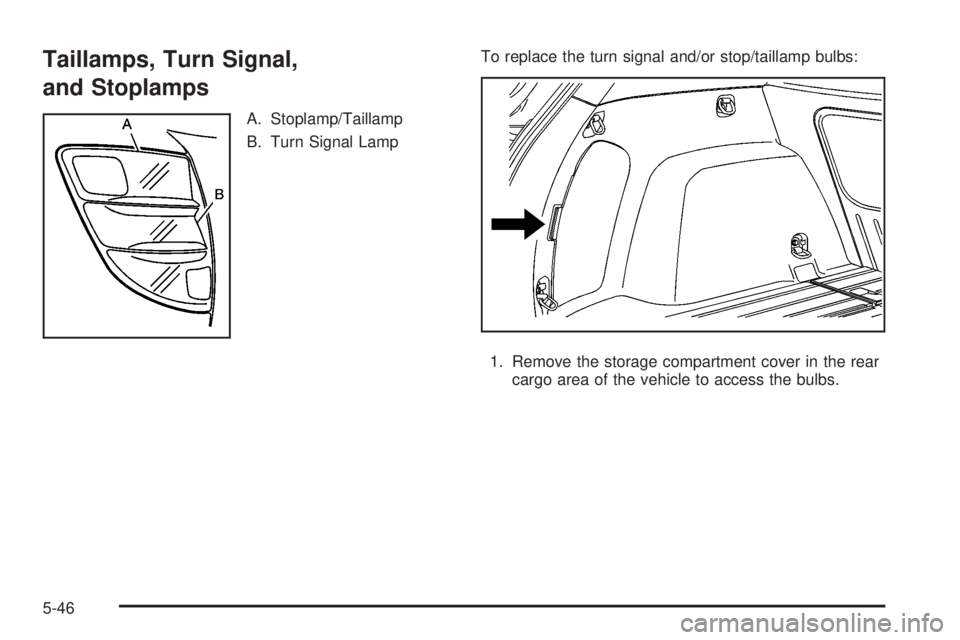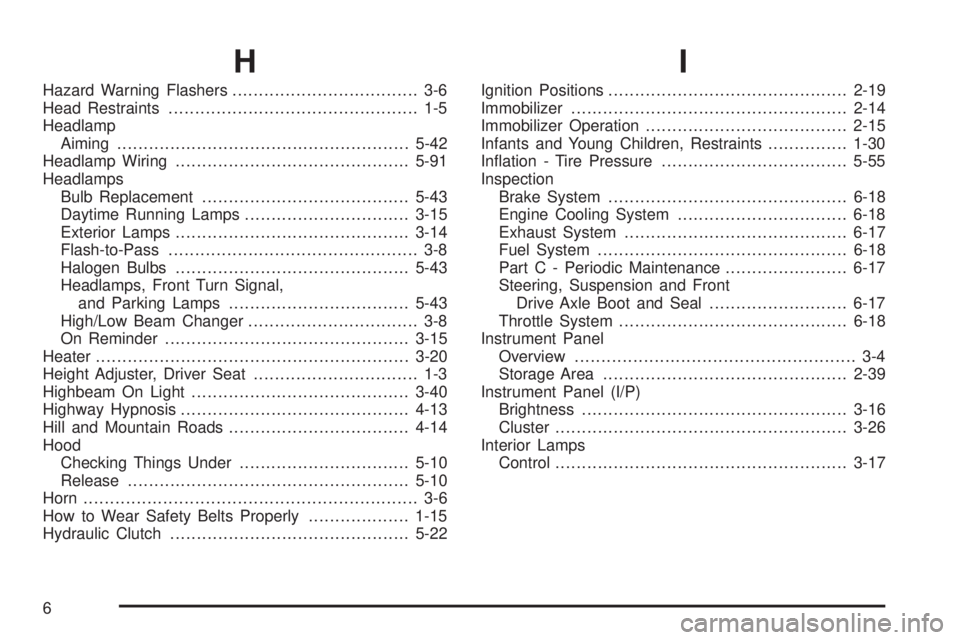turn signal bulb PONTIAC VIBE 2008 Owners Manual
[x] Cancel search | Manufacturer: PONTIAC, Model Year: 2008, Model line: VIBE, Model: PONTIAC VIBE 2008Pages: 368, PDF Size: 5.7 MB
Page 124 of 368

Turn and Lane-Change Signals
The turn signal has an upward (for right) and a
downward (for left) position. These positions allow
you to signal a turn or a lane change.
To signal a turn, move the lever all the way up or
down. When the turn is �nished, the lever will return
automatically.
To signal a lane change, raise or lower the lever until
the arrow starts to �ash. Hold it there until you complete
your lane change. The lever will return by itself when
you release it.
An arrow on the instrument
panel cluster will �ash in
the direction of the turn or
lane change.
If you signal a turn or a lane change and notice the
arrow �ashing rapidly, a signal bulb may be burned
out and other drivers will not see your turn signal.
If a bulb is burned out, have it replaced to help avoid an
accident. If the arrows do not go on at all when you signal
a turn, check for burned-out bulbs and then check the
fuse. SeeFuses and Circuit Breakers on page 5-91.
Headlamp High/Low-Beam Changer
The headlamps must be on for this feature to work.
For high beams, push the turn signal lever away
from you.
When the high beams
are on, this light on the
instrument panel cluster
also will be on.
It will go off when you switch to the low beams.
To switch back to low beams, pull the lever toward you.
Flash-to-Pass
With the lever in the low-beam position, pull the lever
toward you to momentarily switch to high beams
(to signal that you are going to pass). If you have the
headlamps on when you release the lever, they will
return to the low beams.
3-8
Page 212 of 368

Turn Signals When Towing a Trailer
When you tow a trailer, your vehicle may need a different
turn signal �asher and/or extra wiring. Check with your
dealer. The arrows on your instrument panel will �ash
whenever you signal a turn or lane change. Properly
hooked up, the trailer lamps will also �ash, telling other
drivers you’re about to turn, change lanes or stop.
When towing a trailer, the arrows on your instrument
panel will �ash for turns even if the bulbs on the trailer
are burned out. Thus, you may think drivers behind
you are seeing your signal when they are not. It’s
important to check occasionally to be sure the trailer
bulbs are still working.
Driving On Grades
Reduce speed and shift to a lower gearbeforeyou
start down a long or steep downgrade. If you don’t shift
down, you might have to use your brakes so much
that they would get hot and no longer work well.
On a long uphill grade, shift down and reduce your
speed to around 45 mph (70 km/h) to reduce the
possibility of the engine and the transaxle overheating.
Parking on Hills
{CAUTION:
You really should not park your vehicle, with a
trailer attached, on a hill. If something goes
wrong, your rig could start to move. People
can be injured, and both your vehicle and the
trailer can be damaged.
But if you ever have to park your rig on a hill, here’s
how to do it:
1. Apply your regular brakes, but don’t shift into
PARK (P) for an automatic transaxle or into gear
for a manual transaxle, yet. When parking uphill,
turn your wheels away from the curb. When parking
downhill, turn your wheels into the curb.
2. Have someone place chocks under the trailer
wheels.
3. When the chocks are in place, release the regular
brakes until the chocks absorb the load.
4. Reapply the regular brakes. Then apply your
parking brake and shift into PARK (P) for an
automatic transaxle or REVERSE (R) for a
manual transaxle.
5. Release the regular brakes.
4-32
Page 215 of 368

Service............................................................5-3
Accessories and Modi�cations..........................5-3
California Proposition 65 Warning.....................5-3
California Perchlorate Materials Requirements.....5-4
Doing Your Own Service Work.........................5-4
Adding Equipment to the Outside
of Your Vehicle...........................................5-5
Fuel................................................................5-5
Gasoline Octane............................................5-5
Gasoline Speci�cations....................................5-5
California Fuel...............................................5-5
Additives.......................................................5-6
Fuels in Foreign Countries...............................5-6
Filling the Tank..............................................5-7
Filling a Portable Fuel Container.......................5-9
Checking Things Under the Hood....................5-10
Hood Release..............................................5-10
Engine Compartment Overview.......................5-12
Engine Oil...................................................5-13
Engine Air Cleaner/Filter................................5-17
Automatic Transmission Fluid.........................5-19
Manual Transmission Fluid.............................5-21
Hydraulic Clutch...........................................5-22
Engine Coolant.............................................5-23
Radiator Pressure Cap..................................5-26
Engine Overheating.......................................5-26Cooling System............................................5-28
Power Steering Fluid.....................................5-33
Windshield Washer Fluid................................5-34
Brakes........................................................5-35
Battery........................................................5-38
Jump Starting...............................................5-38
Headlamp Aiming...........................................5-42
Bulb Replacement..........................................5-43
Halogen Bulbs
..............................................5-43
Headlamps, Front Turn Signal,
and Parking Lamps....................................5-43
Center High-Mounted Stoplamp (CHMSL).........5-45
Taillamps, Turn Signal, and Stoplamps............5-46
Back-Up Lamps............................................5-47
Replacement Bulbs.......................................5-48
Windshield Wiper Blade Replacement..............5-48
Tires..............................................................5-49
Tire Sidewall Labeling...................................5-50
Tire Terminology and De�nitions.....................5-52
In�ation - Tire Pressure.................................5-55
Tire Pressure Monitor System.........................5-57
Tire Pressure Monitor Operation.....................5-58
Tire Inspection and Rotation...........................5-61
When It Is Time for New Tires.......................5-63
Buying New Tires.........................................5-63
Section 5 Service and Appearance Care
5-1
Page 257 of 368

Bulb Replacement
For the proper type of replacement bulbs, see
Replacement Bulbs on page 5-48.
For any bulb changing procedure not listed in this
section, contact your dealer/retailer.
Halogen Bulbs
{CAUTION:
Halogen bulbs have pressurized gas inside
and can burst if you drop or scratch the bulb.
You or others could be injured. Be sure to
read and follow the instructions on the bulb
package.
Headlamps, Front Turn Signal,
and Parking Lamps
A. Headlamp
B. Turn Signal/Parking Lamp
5-43
Page 258 of 368

To replace the headlamp, turn signal, or parking
lamp bulb:
1. Open the hood and locate the lamp assembly.
2. Remove the rubber cover and socket from
the headlamp or turn signal/parking lamp.3. Release the retainer clip holding the bulb on the
headlamp by pressing down and moving the
metal retainer away from you.
Turn the turn signal/parking lamp bulb socket
counterclockwise to remove.
4. Pull the bulb out of the �xture.
5. Reverse the steps to install a new bulb.
5-44
Page 260 of 368

Taillamps, Turn Signal,
and Stoplamps
A. Stoplamp/Taillamp
B. Turn Signal LampTo replace the turn signal and/or stop/taillamp bulbs:
1. Remove the storage compartment cover in the rear
cargo area of the vehicle to access the bulbs.
5-46
Page 262 of 368

Replacement Bulbs
Exterior Lamp Bulb Number
Back-Up Lamp 7440
CHMSL 921
Front Turn Signal and
Parking Lamp1157NA
Headlamp High/Low-Beam 9003
Rear Turn Signal 7440
Stoplamp/Taillamp 7443
For replacement bulbs not listed here, contact
your dealer.
Windshield Wiper Blade
Replacement
Windshield wiper blades should be inspected at least
twice a year for wear or cracking. See “Wiper Blade
Check” underAt Least Twice a Year on page 6-13
for more information.Replacement blades come in different types and are
removed in different ways. Here’s how to remove
the wiper blade:
1. Pull the windshield wiper arm away from the
windshield.
2. Push the release lever and slide the wiper assembly
toward the driver’s side of the vehicle.
3. Install a new blade by reversing Steps 1 and 2.
5-48
Page 356 of 368

Automatic Headlamp System............................3-16
Automatic Transmission
Fluid..........................................................5-19
Operation...................................................2-23
B
Battery..........................................................5-38
Brake
Emergencies................................................ 4-5
System Inspection.......................................6-18
Brakes..........................................................5-35
Panic Assist................................................. 4-7
System Warning Light..................................3-32
Braking........................................................... 4-3
Braking in Emergencies..................................... 4-5
Break-In, New Vehicle.....................................2-18
Bulb Replacement...........................................5-43
Back-Up Lamps...........................................5-47
Center High-Mounted Stoplamp (CHMSL)........5-45
Halogen Bulbs............................................5-43
Headlamp Aiming........................................5-42
Headlamps, Front Turn Signal, and
Parking Lamps.........................................5-43
Replacement Bulbs......................................5-48
Taillamps, Turn Signal, and Stoplamps............5-46
Buying New Tires...........................................5-63
C
California Fuel.................................................. 5-5
California Perchlorate Materials Requirements....... 5-4
California Proposition 65 Warning....................... 5-3
Canadian Owners................................................ ii
Capacities and Speci�cations............................5-95
Carbon Monoxide...................2-10, 2-32, 4-15, 4-27
Care of
Safety Belts................................................5-85
Cargo Cover..................................................2-42
Cargo Tie Downs............................................2-42
CD, MP3 .......................................................3-58
Center Console Storage Area...........................2-39
Center High-Mounted Stoplamp (CHMSL)...........5-45
Chains, Tire...................................................5-68
Charging System Light....................................3-32
Check
Engine Light...............................................3-36
Checking Things Under the Hood......................5-10
Chemical Paint Spotting...................................5-88
Child Restraints
Child Restraint Systems...............................1-33
Infants and Young Children...........................1-30
Lower Anchors and Tethers for Children..........1-37
Older Children.............................................1-27
Securing a Child Restraint in a
Rear Seat Position...................................1-44
2
Page 360 of 368

H
Hazard Warning Flashers................................... 3-6
Head Restraints............................................... 1-5
Headlamp
Aiming.......................................................5-42
Headlamp Wiring............................................5-91
Headlamps
Bulb Replacement.......................................5-43
Daytime Running Lamps...............................3-15
Exterior Lamps............................................3-14
Flash-to-Pass............................................... 3-8
Halogen Bulbs............................................5-43
Headlamps, Front Turn Signal,
and Parking Lamps..................................5-43
High/Low Beam Changer................................ 3-8
On Reminder..............................................3-15
Heater...........................................................3-20
Height Adjuster, Driver Seat............................... 1-3
Highbeam On Light.........................................3-40
Highway Hypnosis...........................................4-13
Hill and Mountain Roads..................................4-14
Hood
Checking Things Under................................5-10
Release.....................................................5-10
Horn............................................................... 3-6
How to Wear Safety Belts Properly...................1-15
Hydraulic Clutch.............................................5-22
I
Ignition Positions.............................................2-19
Immobilizer....................................................2-14
Immobilizer Operation......................................2-15
Infants and Young Children, Restraints...............1-30
In�ation - Tire Pressure...................................5-55
Inspection
Brake System.............................................6-18
Engine Cooling System................................6-18
Exhaust System..........................................6-17
Fuel System...............................................6-18
Part C - Periodic Maintenance.......................6-17
Steering, Suspension and Front
Drive Axle Boot and Seal..........................6-17
Throttle System...........................................6-18
Instrument Panel
Overview..................................................... 3-4
Storage Area..............................................2-39
Instrument Panel (I/P)
Brightness..................................................3-16
Cluster.......................................................3-26
Interior Lamps
Control.......................................................3-17
6